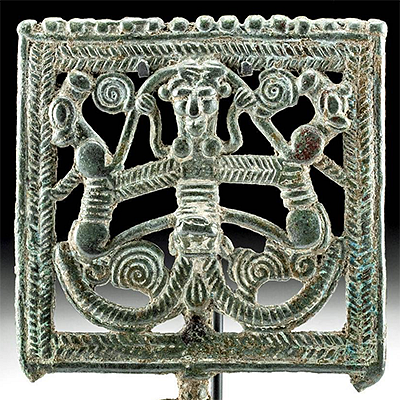Early 20th C. African Dagari Wood Phallic Figure
Lot 97e
About Seller
Artemis Gallery
686 S Taylor Ave, Ste 106
Louisville, CO 80027
United States
Selling antiquities, ancient and ethnographic art online since 1993, Artemis Gallery specializes in Classical Antiquities (Egyptian, Greek, Roman, Near Eastern), Asian, Pre-Columbian, African / Tribal / Oceanographic art. Our extensive inventory includes pottery, stone, metal, wood, glass and textil...Read more
Categories
Estimate:
$1,500 - $2,500
Absentee vs Live bid
Two ways to bid:
- Leave a max absentee bid and the platform will bid on your behalf up to your maximum bid during the live auction.
- Bid live during the auction and your bids will be submitted real-time to the auctioneer.
Bid Increments
| Price | Bid Increment |
|---|---|
| $0 | $25 |
| $300 | $50 |
| $1,000 | $100 |
| $2,000 | $250 |
| $5,000 | $500 |
| $10,000 | $1,000 |
| $20,000 | $2,500 |
| $50,000 | $5,000 |
| $100,000 | $10,000 |
| $200,000 | $20,000 |
About Auction
By Artemis Gallery
Nov 5, 2020
Set Reminder
2020-11-05 10:00:00
2020-11-05 10:00:00
America/New_York
Bidsquare
Bidsquare : Ancient & Ethnographic From Around the World
https://www.bidsquare.com/auctions/artemis-gallery/ancient-ethnographic-from-around-the-world-5916
Ancient art from Egypt, Greece, Italy and the Near East, as well as Asian, Pre-Columbian, Native American, African / Tribal / Oceanic, Spanish Colonial, Russian Icons, Fine art, much more! All categories, all price ranges... all legally acquired and guaranteed to be as described or your money back. Artemis Gallery info@artemisgallery.com
Ancient art from Egypt, Greece, Italy and the Near East, as well as Asian, Pre-Columbian, Native American, African / Tribal / Oceanic, Spanish Colonial, Russian Icons, Fine art, much more! All categories, all price ranges... all legally acquired and guaranteed to be as described or your money back. Artemis Gallery info@artemisgallery.com
- Lot Description
West Africa, Burkina Faso, Lobi Dagari people, ca. early to mid 20th century. A very large, hand-carved wooden phallic figure created by a subgroup of the Lobi people known as the Dagari. This type of figure was intended to be a protective form, and was traditionally placed on lineage or family shrines. This example is among the tallest we have ever seen. Typically, they are about half this size! A fascinating anthropomorphic wooden figure from one of the most abstract artistic traditions in the world. The figure is hand-carved, with long, outspread legs that meet at a narrow waist with a prominent conical phallus protruding from the front. The lengthy, cylindrical torso towers above the delineated legs and terminates with a rounded head on top that boast a pointed chin and no other discernible facial features. Size: 19.625" W x 40.125" H (49.8 cm x 101.9 cm); 40.375" H (102.6 cm) on included custom stand.
Dagari figures represent abstract ideals, hence their abstract forms, and are designed to look mysterious and brooding because they commune with a world beyond human comprehension or even sight. Figures like this one are carved to be kept inside a chamber and atop a personal altar built into a family dwelling. Their role was to protect the home from any misfortune or illness. In exchange, they could demand offerings - food and sacrifices - and also demand additional figures to be placed beside them, leading to an accumulation of similar sculptures in the home.
A Dagari statue of a similar size sold for 13,750 Euros at Christie's Paris Sale 16410 - 27 June 2018 - Lot 29
Provenance: private Houston, Texas, USA collection, purchased from dealers, beginning in the late 1980s to as recently as 2017
All items legal to buy/sell under U.S. Statute covering cultural patrimony Code 2600, CHAPTER 14, and are guaranteed to be as described or your money back.
A Certificate of Authenticity will accompany all winning bids.
We ship worldwide and handle all shipping in-house for your convenience.
#159620Normal age wear with surface wear, losses to peripheries, and areas of inactive insect wear as shown. A few age cracks, the largest one from head about half-way down the side of the piece. A few losses to legs, back of head, and body as shown.Condition
- Shipping Info
-
All shipping is handled in-house for your convenience. Your invoice from Artemis Gallery will include shipping calculation instructions. If in doubt, please inquire BEFORE bidding for estimated shipping costs for individual items.
-
- Buyer's Premium



 EUR
EUR CAD
CAD AUD
AUD GBP
GBP MXN
MXN HKD
HKD CNY
CNY MYR
MYR SEK
SEK SGD
SGD CHF
CHF THB
THB














